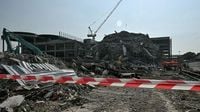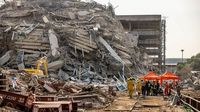A powerful 7.7 magnitude earthquake struck central Myanmar on March 28, 2025, causing widespread destruction and panic across Southeast Asia. The quake, which occurred at 12:50 p.m. local time (2:20 a.m. ET), was centered 16 kilometers northwest of Sagaing, Myanmar's second-largest city. Its impact was felt as far away as Bangkok, Thailand, and even in the Yunnan province of China, leading to emergency declarations and rescue operations in multiple regions.
The tremor was followed by a significant aftershock measuring 6.4, just 12 minutes later, amplifying concerns about further damage and casualties. According to the U.S. Geological Survey (USGS), the earthquake was one of the most powerful to hit the region in recent years, with a depth of 10 kilometers, which contributed to its intensity at the surface.
As of the latest reports, at least six fatalities have been confirmed: three in Myanmar due to the collapse of a mosque in Taungoo, and one construction worker in Bangkok after a skyscraper collapsed. The Thai authorities reported that the building, which was under construction, crumbled in seconds, trapping dozens of workers inside. Rescue efforts are ongoing, with 43 workers initially reported trapped, and many have since been rescued.
In Mandalay, the earthquake caused significant structural damage, with several buildings collapsing and residents fleeing for safety. Eyewitnesses described scenes of chaos as people rushed out of their homes and businesses. One resident recounted, "We ran out of the house when everything started shaking. I witnessed a five-story building collapse right before my eyes. Everyone in my city is outside, and no one dares to go back inside the buildings."
The Prime Minister of Thailand, Paetongtarn Shinawatra, declared Bangkok a "zone of emergency" following the quake, urging residents to avoid high-rise buildings and use stairs instead of elevators. Reports indicated that many tall structures in Bangkok sustained damage, prompting inspections and safety assessments by local authorities.
In Naypyidaw, Myanmar's capital, damage reports included cracks in walls, fallen ceilings, and severely affected roads. The tremor lasted for approximately 30 seconds, forcing the evacuation of the National Museum amidst panic. Witnesses described staff members trembling and crying as they fled the building.
As rescue operations continue, the military junta governing Myanmar has declared a state of emergency in several affected regions, including Mandalay and Naypyidaw. They have pledged to investigate the situation and provide humanitarian aid. The junta's spokesperson stated, "The state will investigate the situation immediately and carry out rescue operations, as well as provide humanitarian assistance."
The earthquake's impact extended beyond Myanmar, with tremors felt in various parts of Thailand and southern China. Residents in Chiang Mai, a popular tourist destination, also reported feeling the quake, leading to evacuations from homes and businesses. The Thai Meteorological Department issued warnings of possible aftershocks, advising residents to remain vigilant.
In the aftermath, the USGS issued a red alert for potential deaths and damages, estimating that the death toll could rise significantly as rescue teams assess the full extent of the disaster. Initial estimates suggested that fatalities could range from a few hundred to possibly thousands, given the region's seismic history and population density.
Myanmar is located on the Sagaing fault line, which has a history of significant seismic activity. According to geophysicist William Yeck, this earthquake is comparable in intensity to the devastating 2023 quake that struck Turkey and Syria, which resulted in over 53,000 deaths. Yeck noted that this earthquake was expected due to the fault's geological history, stating, "We knew that this place, this segment of the fault, was likely to break and cause a major earthquake in the near future."
As the situation continues to unfold, international offers of assistance are being made. Indian Prime Minister Narendra Modi expressed condolences and offered support, stating, "We pray for the safety and well-being of all. India is ready to offer all possible assistance." The international community is closely monitoring the situation, and humanitarian organizations are preparing to respond to the needs of those affected.
In summary, the earthquake that struck Myanmar on March 28 has resulted in significant loss of life and widespread destruction. As rescue efforts are underway, the full impact of this disaster remains to be seen, with many still trapped in the rubble and the potential for further casualties as aftershocks continue to pose risks.









